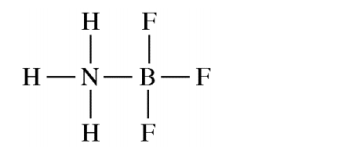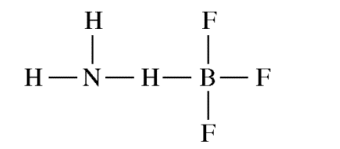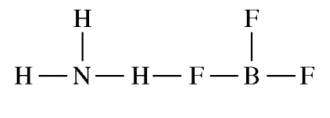
Bonding and Intermolecular Forces Review
Quiz
•
Science, Physics, Chemistry
•
9th Grade - University
•
Hard
+6
Standards-aligned
Rondel Thorpe
Used 9+ times
FREE Resource
50 questions
Show all answers
1.
MULTIPLE CHOICE QUESTION
30 sec • 1 pt

Which of the following can be inferred from the diagram above that shows the dependence of potential energy on the internuclear distance between two atoms?
The atoms form a bond with a bond length of 25pm.
The atoms form a bond with a bond length of 75pm
75pm.
The net force between the atoms is attractive at 25pm
25pm.
The net force between the atoms is attractive at 75pm
75pm.
Answer explanation
The minimum potential energy occurs at an internuclear distance of 75pm, which corresponds to the length of the stable bond that forms between the two atoms. If the atoms were any closer to each other, the net force would be repulsive. Likewise, if the atoms were farther from each other, the net force would be attractive. At 75pm, the net force between the two atoms is zero.
Tags
NGSS.HS-PS3-2
2.
MULTIPLE CHOICE QUESTION
30 sec • 1 pt

Based on the data in the tables above, which of the following statements provides the best prediction for the boiling point of NaCl ?
NaCl will have a lower boiling point than NaF because the coulombic attractions are weaker in NaCl than in NaF .
NaCl will have a boiling point between that of NaF and MgO because the covalent character of the bonds in NaCl is intermediate between that of MgO and NaF.
NaCl will have a higher boiling point than MgO because the ions are spaced farther apart in NaCl .
NaCl will have a higher boiling point than MgO because the energy required to transfer electrons from the anion to the cation is larger in NaCl than in MgO .
Answer explanation
The Cl− ion is larger than the F− ion so the attractive interactions in NaCl are weaker than in NaF.
Tags
NGSS.HS-PS1-3
NGSS.HS-PS2-4
3.
MULTIPLE CHOICE QUESTION
30 sec • 1 pt
Has a central atom with less than an octet of electrons
H2O
NH3
BH3
CH4
SiH4
Tags
NGSS.HS-PS1-1
4.
MULTIPLE CHOICE QUESTION
30 sec • 1 pt
Has two lone pairs on the central atom.
H2O
NH3
BH3
CH4
SiH4
5.
MULTIPLE CHOICE QUESTION
30 sec • 1 pt
Predicted to have the largest bond angles.
H2O
NH3
BH3
CH4
SiH4
6.
MULTIPLE CHOICE QUESTION
30 sec • 1 pt
Has trigonal pyramidal molecular geomtry.
H2O
NH3
BH3
CH4
SiH4
7.
MULTIPLE CHOICE QUESTION
30 sec • 1 pt

The potential energy as a function of internuclear distance for three diatomic molecules, X2, Y2, and Z2, is shown in the graph above. Based on the data in the graph, which of the following correctly identifies the diatomic molecules, X2, Y2, and Z2?
X2 = H2 , Y2 = N2 , Z2= O2
X2 = N2 , Y2 = H2 , Z2= O2
X2 = O2 , Y2 = N2 , Z2= H2
X2 = O2 , Y2 = H2 , Z2= N2
Tags
NGSS.HS-PS1-2
NGSS.HS-PS1-4
Create a free account and access millions of resources
Similar Resources on Wayground

52 questions
Classify Solids
Quiz
•
12th Grade

52 questions
Identify and Classify Solids
Quiz
•
12th Grade

54 questions
AP Chem Unit Thou Shalt Not Forget
Quiz
•
10th Grade - University

54 questions
AP Chemistry Unit 6 Thou
Quiz
•
10th Grade - University

54 questions
AP Chemistry Thou Shall Not Forget
Quiz
•
10th Grade - University

54 questions
AP Chem Unit 8
Quiz
•
10th Grade - University

54 questions
Bonding Unit Review
Quiz
•
11th Grade

45 questions
Q3 PHYSICAL SCIENCE Q3
Quiz
•
12th Grade
Popular Resources on Wayground

12 questions
Unit Zero lesson 2 cafeteria
Lesson
•
9th - 12th Grade

10 questions
Nouns, nouns, nouns
Quiz
•
3rd Grade

10 questions
Lab Safety Procedures and Guidelines
Interactive video
•
6th - 10th Grade

25 questions
Multiplication Facts
Quiz
•
5th Grade

11 questions
All about me
Quiz
•
Professional Development

20 questions
Lab Safety and Equipment
Quiz
•
8th Grade

13 questions
25-26 Behavior Expectations Matrix
Quiz
•
9th - 12th Grade

10 questions
Exploring Digital Citizenship Essentials
Interactive video
•
6th - 10th Grade
Discover more resources for Science

17 questions
Lab Safety
Interactive video
•
10th Grade

10 questions
Lab Safety Essentials
Interactive video
•
6th - 10th Grade

16 questions
Metric Conversions
Quiz
•
11th Grade

10 questions
Exploring Types of Matter: Elements, Compounds, and Mixtures
Interactive video
•
6th - 10th Grade

10 questions
Exploring the Scientific Method
Interactive video
•
6th - 10th Grade

12 questions
Lab Safety
Quiz
•
6th - 12th Grade

13 questions
Amoeba Sisters: Biomolecules
Interactive video
•
9th - 12th Grade

10 questions
Exploring Latitude and Longitude Concepts
Interactive video
•
6th - 10th Grade




